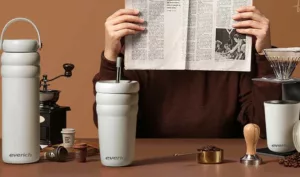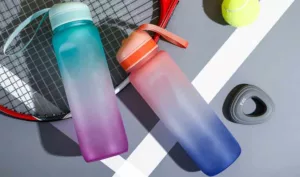What Is A YETI Cup?
YETI is an American company dedicated to designing and selling rugged outdoor thermal containers and mugs. Their products are beloved by American consumers for their practicality, durability, and ruggedness. Their mug products have consistently ranked highly in sales on the Amazon platform.
Based on the monthly sales data of thermal mugs on the Amazon platform that we have been tracking, the YETI brand has maintained a market share of over 20% for the past two years, peaking at 44%. Among numerous thermal mug brands, YETI holds a leading position. Retailers state that YETI thermal mugs are highly sought after by consumers due to their strong insulation capabilities and affordable pricing.
YETI Tumbler Manufacturing Process
The main production process by YETI tumbler manufacturer is shown below:
Sheet Preparation: Stainless steel sheets are cut into appropriate sizes for the tumbler. These sheets typically have a thin layer of insulation material, such as foam or vacuum-sealed air, sandwiched between two layers of stainless steel.
Deep Drawing and Forming: Similar to the process described earlier, the stainless steel sheet is deep drawn into the desired tumbler shape using a combination of dies and punches.
Insulation Layer Insertion: For vacuum-sealed insulation, the inner and outer stainless steel layers are pressed together, and the air between them is evacuated to create a vacuum insulation panel. For foam insulation, the insulation layer is placed between the two stainless steel layers before sealing.
Welding and Sealing: The top and bottom openings of the tumbler are sealed to enclose the insulation layer. This can involve processes like laser welding, friction welding, or other sealing techniques, depending on the manufacturer’s capabilities.
Finishing and Polishing: Excess material from the welding process is trimmed, and the tumbler’s exterior is polished to achieve the desired finish.
Lid and Component Assembly: If the tumbler includes a lid, handles, or other components, they are attached at this stage. These components might be welded, screwed, or otherwise securely attached to the tumbler.
Quality Control: Each tumbler undergoes quality control checks to ensure that it meets specifications for insulation effectiveness, structural integrity, and aesthetics.
Surface Treatment: Optional surface treatments, such as powder coating, painting, or adding decorative designs, might be applied to enhance the appearance and protect the tumbler’s exterior.
Packaging: The finished insulated tumblers are packaged for shipping and distribution.
Click here to learn about YETI Tumbler Manufacturing Process.
How Does YETI Cup Work?
Stainless steel insulated tumblers exhibit excellent insulation performance and numerous advantageous qualities. The inner liner and outer shell of stainless steel vacuum insulated containers are welded together, and the space in between is vacuum-sealed to achieve effective insulation. Stainless steel material itself possesses excellent corrosion resistance and good resistance to intergranular corrosion. Thermal containers made from stainless steel material outperform those made from glass, ceramics, plastics, and other materials due to their superior insulation, corrosion and high-temperature resistance, high strength, seismic resistance, safety portability, hygiene, bright appearance, and other exceptional product characteristics.
Driven by consumer upgrading and process improvement, thermal tumblers have been endowed with more features. With the overall improvement in residents’ purchasing power, consumers have higher demands for the aesthetic appearance, customization, fashionability, technological intelligence, and product quality of thermal containers. The high malleability of stainless steel material and its ease of molding provide a broader scope for product design creativity. In recent years, manufacturing processes have been progressively enhanced. Combined with the growing emphasis on environmental and health factors, stainless steel thermal containers have been imbued with additional product features in response to the evolution of the times.
What Materials Are Used To Make YETI Ramblers?
YETI Ramblers are made primarily from stainless steel. The stainless steel used in YETI products is known for its durability, corrosion resistance, and excellent insulation properties. The specific type of stainless steel used in YETI products is often referred to as “18/8 stainless steel,” which means it contains 18% chromium and 8% nickel. This combination of metals contributes to the stainless steel’s resistance to corrosion and staining.
In addition to the stainless steel body, YETI tumbler manufacturer may also have other materials for components such as lids, seals, and handles. For instance, the lids might include a combination of materials like BPA-free plastic, silicone gaskets, and other food-safe materials to ensure a secure and leak-proof seal.
The choice of materials is aimed at providing YETI Ramblers with their signature insulation capabilities and durability, making them effective at keeping beverages hot or cold for extended periods while also being rugged enough to withstand outdoor and everyday use.
Where Are YETI Tumblers Made?
YETI tumblers and products are primarily designed in the United States, but the manufacturing locations can vary. While YETI tumbler manufacturer started with manufacturing in the United States, due to factors like production scale and cost, some of their products have been manufactured in other countries as well.
How To Buy YETI Wholesale?
Buying YETI products wholesale typically involves working directly with authorized distributors or contacting YETI directly to inquire about their wholesale purchasing options. Here’s a general outline of the steps you can take:
Contact YETI Directly: Start by reaching out to YETI’s customer service or sales team. You can visit their official website and look for information on wholesale or bulk purchasing. They may have a dedicated section for wholesale inquiries or a contact form for businesses interested in buying their products at wholesale prices.
Provide Business Information: When you contact YETI, be prepared to provide information about your business, such as its name, location, type (retail store, online shop, distributor, etc.), and your business license or tax identification number. This information helps YETI verify that you’re a legitimate business.
Discuss Terms and Conditions: YETI will likely provide you with information about their wholesale terms, pricing, minimum order quantities, and any other relevant details. It’s important to understand their requirements and policies before proceeding.
Place Wholesale Order: If you’re satisfied with the terms, you can place a wholesale order for the desired YETI products. Depending on the arrangement, you may need to meet a minimum order quantity or order value.
Payment and Shipping: YETI will provide information about payment methods and shipping options for your wholesale order. Payment terms may vary, so make sure to clarify payment terms and deadlines.
Establish Relationship: Building a good relationship with YETI’s wholesale team can be beneficial for future orders and collaborations. Clear communication and professionalism go a long way in establishing a positive business partnership.
Keep in mind that YETI, like many brands, may have specific eligibility criteria for wholesale buyers, and they may not approve every inquiry. It’s essential to be prepared and professional when contacting them, as well as to inquire about any potential requirements or obligations associated with being a YETI wholesaler.




